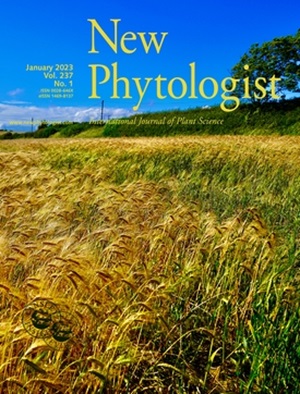Drastic mycorrhizal community shifts in Sceptridium ferns during the generation transition from fully mycoheterotrophic gametophytes to photosynthetic sporophytes
IF 8.3
1区 生物学
Q1 PLANT SCIENCES
引用次数: 0
Abstract
- Many plant species experience a prolonged subterranean phase during which they rely entirely on mycorrhizal fungi for carbon. While this mycoheterotrophic strategy spans liverworts, lycophytes, and ferns, most empirical research has centered on angiosperms.
- This study explores the fungal associations of Sceptridium (Ophioglossaceae), an early-diverging fern with mycoheterotrophic gametophytes. We analyzed germination patterns and fungal associations in Sceptridium gametophytes, comparing them to the distribution and mycorrhizal partners of photosynthetic sporophytes.
- High-throughput sequencing data reveal that mycoheterotrophic gametophytes consistently associate with a single Entrophospora fungus in the order Entrophosporales (Glomeromycotina), while photosynthetic sporophytes primarily partner with fungi from Glomeraceae (Glomerales, Glomeromycotina). Consequently, gametophytes exhibit spatial clustering without association with adult plants. This is the first documentation of an association between Entrophosporaceae (and the order Entrophosporales) and mycoheterotrophic plants.
- The drastic shifts in Sceptridium mycorrhizal communities across life stages likely reflect changing physiological needs during development. Further research is essential to determine whether the association with Entrophosporaceae is widespread among mycoheterotrophic species and to elucidate the functional and physiological mechanisms underlying these mycorrhizal shifts.
求助全文
约1分钟内获得全文
求助全文
来源期刊

New Phytologist
生物-植物科学
自引率
5.30%
发文量
728
期刊介绍:
New Phytologist is an international electronic journal published 24 times a year. It is owned by the New Phytologist Foundation, a non-profit-making charitable organization dedicated to promoting plant science. The journal publishes excellent, novel, rigorous, and timely research and scholarship in plant science and its applications. The articles cover topics in five sections: Physiology & Development, Environment, Interaction, Evolution, and Transformative Plant Biotechnology. These sections encompass intracellular processes, global environmental change, and encourage cross-disciplinary approaches. The journal recognizes the use of techniques from molecular and cell biology, functional genomics, modeling, and system-based approaches in plant science. Abstracting and Indexing Information for New Phytologist includes Academic Search, AgBiotech News & Information, Agroforestry Abstracts, Biochemistry & Biophysics Citation Index, Botanical Pesticides, CAB Abstracts®, Environment Index, Global Health, and Plant Breeding Abstracts, and others.
 求助内容:
求助内容: 应助结果提醒方式:
应助结果提醒方式:


